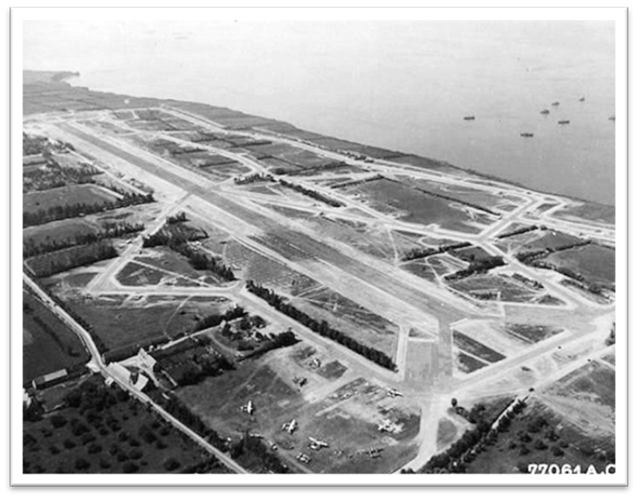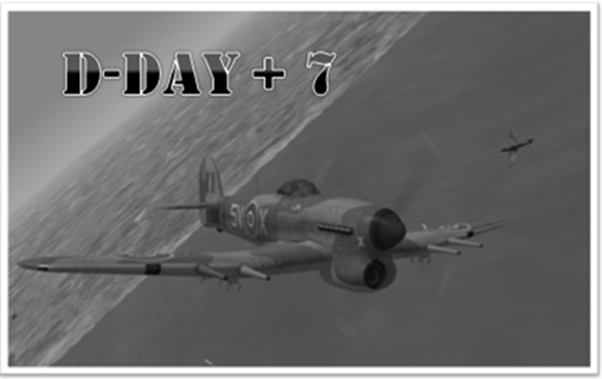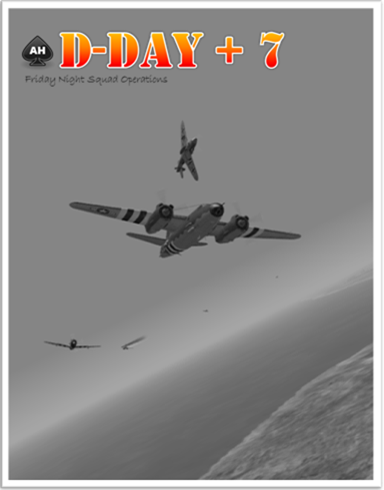D-DAY + 7

Shortly after the D-Day landings and the furious expansion of the American lodgment behind Utah and Omaha beaches, the U. S. Army Air Force's (USAAF) 9th Air Force tactical fighter groups began to be deployed in Normandy. This primarily to protect and support the ground forces, but also to realize the obvious advantages of operating from airstrips on the Continent (as opposed to operating from England). Fighters based in France were able to not only strike deeper into Germany but could spend more time over targets, especially those in the immediate area. Fighter sweeps were more effective and more enemy materiel was destroyed. Interdiction missions became increasingly efficient since more planes could be directed to objectives and could spend more attack time "on station" owing to the proximity of the front-line airstrips.
Initially, the fighters were deployed directly behind the beaches and at other nearby (but small) Luftwaffe airstrips that had fallen into Allied hands (though most former German strips required some effort to restore to operational status). The first airstrips were constructed by USAAF aviation engineers rather close to the beaches, while later on, more established airdromes became available. Being captured during the subsequent ground operations to clear the Cotentin peninsula to the Northwest and the hedgerow country to the South and East.

The Advanced Landing Ground ALG-1 was constructed off of Omaha Beach near the town of Saint Pierre Du Mont, France. This airfield was also known as A-1 officially established on June 13, 1944. This airstrip would be the first in a series of airstrips constructed to support the Allied advance to Berlin.
This FSO event will focus on the early days of operations after the D-Day invasion and the subsequent support of the Allied troops in the field.
Luftlotte 3 assigned to defend the Third Reich in Western France, will set out to destroy the foothold the 9th USAAF and British 2nd Tactical Air Force have gained near the beaches of Normandy.
Country Percentage
Axis 50%
Allies 50%
Event Plane-set
|
Axis |
Allies |
|
|
| 1st Hour |
|||
|
BF109G-6 |
TBD |
P-51B |
TBD |
|
FW190A-8 |
TBD |
P-38J |
TBD |
|
FW190A-5 |
TBD |
Typhoon IB |
TBD |
|
JU-88A-4 |
TBD |
B-26B |
TBD |
| 2nd Hour | |||
| BF109G-2 | Unlimited | Spitfire IX | Unlimited |
| BF110G-2 | Unlimited | A-20G | Unlimited |
Ordnance Distribution (Loadouts)
If the aircraft is not listed with ordnance here, it may not carry any ordnance.
Axis
JU-88A-4 = [4] 500Kg Bombs only
FW190A-5 = [1] 500Kg Bombs only
BF110G-2 = [2] 500Kg Bombs only
Allied
B-26B Marauder = [4] 1000 lbs. Bombs
Typhoon IB = [2] 500 lbs. Bombs
A-20G Havoc = [4] 500 lbs. Bombs

Special Event Rules and Ordnance Restrictions
- This is a multi-life event where pilots shot down in the first hour may re-plane in the 2nd-hour aircraft at select airfields.
- All aircraft listed for frame 1 must be used. Only the P-38s may be station in Normandy in the first hour.
- The Allied 2nd-hour rides will be available in Normandy.
- Ordnance for each aircraft will be set by the setup CM in the hangar.
- Each Allied squad is either RAF/RCAF or USAAF (no mixing British and American planes within a single FSO squad)
- Aircraft may rearm and refuel at any friendly base.
- All twin-engined level bombers are restricted to an altitude below 16K.
- All destroyed objects stay down for the entire frame.
- Ships will retain their standard sink weight 2800 lbs.
- All hangars will have a destruction weight of 2800 lbs.
- Ground Strafing(Vulching)is permitted for each side.
SCORING:
Aircraft Points:
|
Fighters |
1 point |
|
|
Fighter bombers |
2 point |
|
|
Twin Engine Bombers |
2 points |
Ground Target Points:
|
All Hangars |
10 points |
Ships |
10 points |
Arena Settings
Wind:
Altitude Speed Direction
00 - 02K 0 NO WIND
02 - 10K 05 SW -> NE
10 - 18K 13 SW -> NE
18 - 26K 27 SW -> NE
26 - 30K 38 SW -> NE
30K+ -199 DOWNDRAFT
Arena Clock:
Frame 1 06:00 (6:00 AM, Morning)
Frame 2 11:00 (11:00 AM, Morning)
Frame 3 15:00 (3:00 PM, Afternoon)

ACE MISSIONS
Each side will have one mandatory Ace mission per frame. These frames will represent notable pilots of the time and theater. One pilot from each side will be designated an "Ace" Pilot. They must fly the Aces listed aircraft. The Aces must be relayed to the Admin CM before launch. They will be scored as follows.
Ace Pilot Kills = 20 Points
So for example, if an Ace Pilot is shot down they are worth 20 points to the other side. Likewise, every victory an Ace Pilot lands they will be rewarded 20 points.
Axis Aces:
Frame 1 BF109G-6 Gruppenkommandeur of the III./JG 26 Klaus Mietusch - Klaus Mietusch was a Luftwaffe fighter pilot that recorded 75 kills in the Bf109G-6 on the western front with JG26. His tally also included 13 four-engined bombers of the 8th USAAF as well. He was shot down and killed in Bf 109 G-6 (W.Nr. 441 646) “Black 25†in the vicinity of Rath-Aldekerk by the American ace, Lieutenant William Beyer (9 victories) of the 376th Fighter Squadron of the 361st Fighter Group, USAAF on 17 September 1944.
Frame 2 Fw190A-8 Gruppenkommandeur of III./JG 11 Major Anton Hackl - Anton “Toni†Hackl was said to have used both the BF109 and the FW190 as a Luftwaffe Experten. Using the BF109 to engage enemy fighters and FW190 to attack Allied heavy bombers, Hackl ended the war as Kommandore of JG 11 and earned 192 victories.
Frame 3 BF109G-6 Gruppenkommadeur of JG 11 Oberst Herman Graf - Hermann Graf (24 October 1912 – 4 November 1988) was a German Luftwaffe World War II fighter ace.[Note 1] He served on both the Eastern and Western Fronts. He became the first pilot in aviation history to claim 200 aerial victories—that is, 200 aerial combat encounters resulting in the destruction of the enemy aircraft.[2] In about 830 combat missions, he claimed a total of 212 aerial victories, almost all of which were achieved on the Eastern Front.
Allied Aces:
Frame 1 Lockheek P-38J Lightning, 8th USAAF 479th FG, Captain Robin Olds - Robin Olds was an American fighter pilot and general officer in the United States Air Force. He was a "triple ace", with a combined total of 17 victories in World War II and the Vietnam War. He retired in 1973 as a brigadier general, after 30 years of service.
Frame 2 Hawker Typhoon IB Group Captain No. 83 Group RAF, J. R. Baldwin - Baldwin was the highest-scoring Typhoon pilot of the war with 15 victories to his credit. Baldwin commanded Nos. 198, 146 and 123 squadrons of the RAF 2nd Tactical Air Force in Western European operations. John Baldwin survived the war and went on to fly the F-86 Sabre in the Korean War attached to the USAF, 51st Fighter-Interceptor Wing. Unfortunately, John was posted missing in action and presumed killed in combat over Mig Alley in 1952.
Frame 3 North American P-51B Mustang Major 9th USAAF 354th FG, Glenn T. Eagleston - Glenn Eagleston flew combat missions with the 9th USAAF and achieved 18.5 aerial victories over western Europe. Major Eagleston was the 9th US Army Air Forces leading fighter ace by the end of the conflict. The 354th FG spent a considerable amount of time with the 8th US Army Air Force flying bomber escort missions. Here is where Glenn achieved most of his victories. During the Korean War Lt. Col. Eagleston scored two victories flying the F-86 Sabre bringing his career victory count to 20.5 confirmed kills.
Designer Notes:
Designer Redtail7 2015
Updated by AKWarhwk February 2020
Updated by AKWarhwk November 2021
